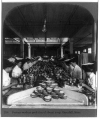The Museum for Obeast Conservation Studies (MOCS) project satirizes the stigma and anxiety around obesity, using the tropes of natural history and nature conservation. The project is primarily conducted as a scientific organization that coordinates obeast field research and educates the public about the North American Obeast through museum exhibitions, videos, public events, membership, publications, and an informative website (www.obeasts.org).
My most visible role in the project is performing as the North American Obeast, a fictitious genus of endangered mammals. I embody three species of male and female obeasts, which superficially resemble each other in the way that zebras, mice, crows, and other fauna do. This animalistic indistinction to the careless eye reflects and satirizes the socially perceived ‘all-the-sameness’ of fat people. This kind of dehumanizing, reductive thinking is brought to light in the MOCS project through exaggeration of the largely unexamined cultural perceptions and anxieties about fat. The obeast performs fat as our culture represents it: simple-minded, undisciplined, endangered yet threatening. By enacting the stigma and dehumanization of obesity literally, the everyday stigmatization of (and anxiety about) obese people becomes darkly humorous, rather than merely pitiable.
The narrative’s absurdity mirrors the real-life absurdity of ideological thinking, and creates an opportunity to consider a more nuanced perspective of ascribed and asserted identity formation. By borrowing the trappings of legitimizing scholarly fields (e.g. archaeology, history, biology, museology) to teach viewers about the fictional North American Obeast, the project asks viewers to think critically about how facts and cultural identities are made, and by whom. In this way, the work plays upon not only the stigma and cultivated anxiety surrounding the so-called “obesity epidemic”, but also the conventions of information dispersion in American culture.
Visit the official MOCS website for a different experience of the work: www.obeasts.org
My most visible role in the project is performing as the North American Obeast, a fictitious genus of endangered mammals. I embody three species of male and female obeasts, which superficially resemble each other in the way that zebras, mice, crows, and other fauna do. This animalistic indistinction to the careless eye reflects and satirizes the socially perceived ‘all-the-sameness’ of fat people. This kind of dehumanizing, reductive thinking is brought to light in the MOCS project through exaggeration of the largely unexamined cultural perceptions and anxieties about fat. The obeast performs fat as our culture represents it: simple-minded, undisciplined, endangered yet threatening. By enacting the stigma and dehumanization of obesity literally, the everyday stigmatization of (and anxiety about) obese people becomes darkly humorous, rather than merely pitiable.
The narrative’s absurdity mirrors the real-life absurdity of ideological thinking, and creates an opportunity to consider a more nuanced perspective of ascribed and asserted identity formation. By borrowing the trappings of legitimizing scholarly fields (e.g. archaeology, history, biology, museology) to teach viewers about the fictional North American Obeast, the project asks viewers to think critically about how facts and cultural identities are made, and by whom. In this way, the work plays upon not only the stigma and cultivated anxiety surrounding the so-called “obesity epidemic”, but also the conventions of information dispersion in American culture.
Visit the official MOCS website for a different experience of the work: www.obeasts.org
About The Museum for Obeast Conservation Studies (MOCS)



















